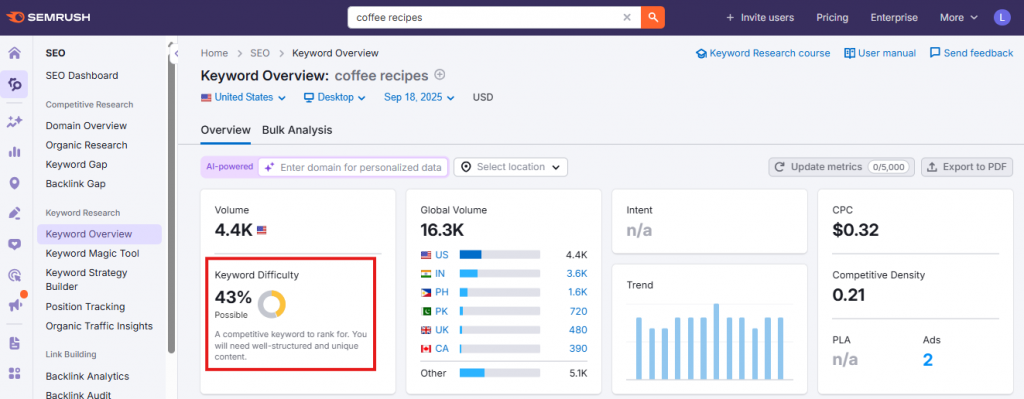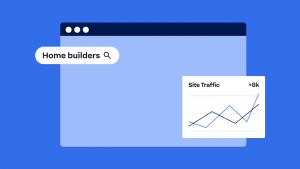Key takeaways:
- Keyword difficulty is a score that calculates how hard it is to rank for a certain keyword in search engines like Google.
- Knowing the keyword difficulty lets you avoid highly competitive words and focus on keywords that can give you better chances of ranking.
- Popular SEO tools have their own proprietary scoring systems, but you should generally aim for ‘relatively easy’ keywords, although medium-difficulty ones can occasionally be realistic targets.
If you’ve ever tried to rank your website on Google, you’ve probably asked yourself: “Why is it so hard to show up on page one?” Sometimes, the answer comes down to keyword difficulty. It’s no different from trying to grab the last parking spot in a crowded lot—the more competition, the harder it is to claim your space.
For small businesses, this number matters. Search engine advertising aside, if you’re a small or local business, you don’t want to waste energy targeting high difficulty keywords dominated by big, established brands. Instead, understanding keyword difficulty score helps you find realistic opportunities for your business to show up organically in search engines.
Let’s break down what keyword difficulty means and how you can actually use it to make smarter keyword choices.
What is keyword difficulty in SEO?
Keyword difficulty (often called KD or SEO keyword difficulty) is a metric that estimates how hard it would be to rank for a keyword in search engine results pages (SERPs). Most SEO tools measure keyword difficulty on a scale of 0–100. Lower numbers mean easier opportunities, while higher numbers reflect strong competition from established sites with high domain authority.

Why is keyword difficulty important in SEO?
Keyword difficulty helps guide your keyword research. Rather than targeting the harder phrases, you can choose keywords where you actually stand a chance of appearing in organic search results.
Let’s say you run a brand-new blog for your local coffee shop business. You research the keyword “coffee recipes” and find it has a keyword difficulty score of around 50, suggesting the top results are dominated by other (possibly more established) websites (, as illustrated in the example below:
Search engine results page (SERP) for “coffee recipes”, with allrecipes.com and athome.starbucks.com as the top organic pages to beat:

That’s just one with a ‘moderate’ keyword difficulty according to Moz:

Or a ‘possible’ (43%) keyword difficulty according to SEMrush:

If your site is new, it would be nearly impossible to outrank them in the short term. Instead, you’ll discover the keyword “coffee smoothie recipes” with a keyword difficulty score of 42.

While the search volume may be smaller, it’s comparatively easier to rank for and get more organic clicks, and it attracts a highly targeted audience. By creating content around this long-tail keyword, your blog has a realistic chance of showing up on page one and actually bringing in traffic.
Rather than chasing competitive phrases, you should choose the opportunities where you actually stand a chance of appearing in organic search results. For small businesses, this means saving money, time, and effort.
If you want to learn more about SEO, you can read our article on What is SEO: Simple Guide for Optimizing Websites for Organic Search.
What are the factors that affect keyword difficulty ?
There is no single formula to measure keyword difficulty, and each SEO tool has its own proprietary method, but many of them consider the following factors:
- Backlink profile
- Competition
- Domain and page authority
- Search volume
- Search intent
- SERP features
- Keyword length and specificity
Backlink profile
A web page’s backlink profile refers to the quantity and quality of external links pointing to it. SEO tools take that into account, and if the first page is filled with results that have dozens (or hundreds) of links from trusted sites, the keyword gets a higher difficulty score. Search engines treat these backlinks as votes of confidence, meaning you’ll need a similarly strong link profile to compete.
Competition
Keyword difficulty also reflects how strong and optimized the current top-ranking content is. If the first page is dominated by high-authority websites, it will be much harder to break through. Tools factor this in by analyzing the authority and optimization of those pages, raising the score when the competition is tougher.
Domain and page authority
Domain authority and page authority are metrics popularized Moz. (Ahrefs uses ‘Domain Rating’ while SEMrush uses ‘Authority Score’). These all estimate the strength and credibility of a website and its individual pages in the eyes of search engines. When top-ranking results come from high-domain authority, keyword difficulty increases. This is because established sites with strong reputations and backlinks make it harder for new or less authoritative pages to outrank them.
Search volume
While search volume isn’t a direct ranking factor, it does correlate with competition levels and influences keyword difficulty scores. Keywords with high search volumes promise more traffic, but they’re also often more competitive and, in turn, drives up the KD score.
Seasonal trends or sudden spikes in popularity can temporarily increase the difficulty of keywords. For example, “holiday gifts” may become highly competitive during the winter season. The goal is to find keywords with enough search volume and relevance to your content to drive traffic, but not so much competition that ranking becomes an uphill battle.
Search intent
Tools consider how well the existing search results match user intent. Search intent is about understanding why someone is using a specific keyword in a search engine, whether it’s informational, commercial, transactional, or navigational.
If the intent is clear (like “how to knot a tie” is clearly informational), it’s easier to see what kind of content ranks. But when a keyword has mixed intent (like “apple” could mean the fruit or the brand), the SERPs display a mix of content types. This makes the keyword more competitive, and the KD score may reflect that variety.
SERP features
SERP features, such as featured snippets, knowledge panels, or local packs, are special boxes or areas on a search engine results page that can display information in a unique and eye-catching way. These features often get a lot of clicks and attention, making it more challenging for organic search results to stand out, even if they’re on the first page.
For certain keywords, particularly those related to shopping or business, ads can take up a prominent position on the page, pushing down the organic (non-paid) results and making them less likely to show up.
SEO tools may rate these keywords as harder because ranking in the top 10 doesn’t guarantee visibility if other elements dominate the page.
Keyword length and specificity
Keyword length and specificity refer to how detailed and specific a keyword is. Longer, more specific keywords, known as long-tail keywords, usually have lower competition and are easier to rank for because they target a more specific audience or topic.
On the other hand, broad and general keywords face higher competition and are harder to rank for due to their wide appeal and the large number of websites trying to rank for them. For example, it’s easier to rank for a specific keyword like “best organic dog food for small breeds” than for a broad one like “dog food.”
Note: KD is not a Google metric. It’s an estimate created by SEO tools to help you gauge how competitive a keyword might be. Think of it as a directional guide, not an absolute truth.
Comparison of keyword difficulty formulas per SEO tool
When it comes to keyword research, Ahrefs, SEMrush, and Moz are some of the top tools available for SEO, so let’s take a look at what their metrics are.
| Tool | Scale | Primary factors | Strengths | Weaknesses |
| Ahrefs | 0–100 | Backlinks to top 10 results | Straightforward metric | Doesn’t weigh content quality heavily |
| SEMrush | 0–100 | Domain authority, backlinks, SERP features | Balanced view of competition | Can feel complex for beginners |
| Moz | 0–100 | Page authority, domain authority | Simple and clear scoring | Less detail than other tools |
No single method is exact, and these tools are tight-lipped when it comes to the actual calculations they do. Understand that these numbers help compare opportunities, not predict rankings with certainty.
What is a good keyword difficulty score?
A good keyword difficulty depends on your website’s strength and goals. Here’s a general breakdown:
- 0–29 = Easy: Great for new websites and blogs.
- 30–49 = Medium: Achievable with consistent effort and some backlinks.
- 50–69 = Hard: Requires stronger domain authority and quality content.
- 70+ = Very hard: Usually only realistic for well-established sites.
Important: Keyword difficulty ranges are only guidelines and not absolute rules. As mentioned, different SEO tools calculate it differently, and your site’s authority also affects what’s realistic. There’s more to SEO content planning than keyword difficulty alone.
As a local coffee shop, you should especially avoid targeting the keyword “coffee” (KD 80+) and instead aim for a good keyword difficulty phrase such as “quick coffee recipes for busy moms” (KD 20). This way, you’re aligning search volume, search intent, and realistic keyword competition.
How to use keyword difficulty in your SEO strategy
Keyword difficulty works best when combined with search volume and search intent.
Using keyword difficulty effectively goes beyond just picking easy keywords. Don’t just chase the lowest scores. Sometimes, a moderately difficult keyword is a good target if the top-ranking content is outdated. The goal is to balance a keyword’s potential with the effort it will take to rank.
This is why successful SEO strategies combine quantitative metrics with qualitative analysis of the actual search results. Specifically, they look at the following best practices:
- Brainstorm potential keywords
- Use SEO tools for assessment
- Evaluate search volume and competition
- Analyze competitor strategies
- Identify long-tail opportunities
- Enhance on-page SEO
- Build a strong backlink profile
- Use internal linking
- Target SERP features
- Monitor and adapt
Let’s delve into each best practice in more detail.
Brainstorm potential keywords
Define your niche and think like your audience. What questions are they asking? What problems are they solving? Use keyword research strategies and tools to expand your list with related phrases you might not come up with on your own.
Use SEO tools for assessment
Enter your keywords into tools like Ahrefs, SEMrush, or Moz. Pay attention to keyword difficulty scores (competitiveness), search volume (traffic potential), and the authority of competing pages. This gives you a realistic sense of which particular keywords are worth targeting.
Evaluate search volume and competition
A keyword with huge traffic may look appealing, but the first page is stacked with authority sites, ranking will be nearly impossible. Aim for terms with a healthy balance of volume and competition so you’re not wasting effort.
Analyze competitor strategies
Look at the content that currently ranks. How detailed is it? What formats do they use (guides, videos, lists)? Use SEO tools to review their backlink profiles and see where their authority comes from. These insights show what you’re up against and how you can stand out.
Identify long-tail opportunities
Long-tail keywords are more specific and less competitive. They may drive smaller traffic numbers but often convert better because they match precise intent. Use tools to uncover long-tail phrases that align with your audience and are within reach.
Enhance on-page SEO
Make your content easy for both users and search engines to understand. Place keywords naturally in titles, headings, and metadata. Keep content well-structured with short paragraphs, clear headings, and bullet points. Don’t over-optimize — focus on clarity and usability.
Build a strong backlink profile
Backlinks remain one of the strongest signals of authority. Create valuable, shareable content like in-depth guides or infographics, and promote it across channels to attract natural links. Guest posting, collaborations, and active participation in your niche community can also help build high-quality backlinks.
Use internal linking
Connect your content together with strategic internal links. This spreads link equity across your site, strengthens topical relevance, and makes it easier for users to discover related content. Use descriptive anchor text so search engines (and readers) understand the context of the linked page.
Target SERP features
Optimize your content to win featured snippets, local packs, or other SERP features. Structure answers clearly, use lists where appropriate, and optimize for local or niche queries if relevant. These features can drive significant visibility even if you don’t rank #1.
Monitor and adapt
SEO is ongoing. Track your rankings, traffic, and conversions, and adjust as search algorithms evolve. Update outdated content, refine your keyword targets, and keep building authority. Treat keyword difficulty as a guidepost, not a one-time task.
Rank first in the keyword competition
Keyword difficulty is important for navigating SEO. By learning how to measure keyword difficulty, spotting what a good keyword difficulty score looks like, and applying it to your keyword research, you’ll stop wasting energy on impossible goals and start building visibility where it counts.
For small businesses, this means making smarter choices: aligning content with search intent, prioritizing achievable target keywords, and gradually building domain authority to compete in organic search results.
Need help with your keyword strategy? Network Solutions SEO Services can guide your strategy. Start optimizing today and let your business take the lead in search engine rankings.

Frequently asked questions
A good keyword difficulty score is usually between 20–40 for small businesses. It’s low enough to be achievable but still attracts meaningful search volume.
There isn’t one universal formula. Tools like Ahrefs, SEMrush, and Moz use different factors such as backlinks, domain authority, and search engine results page competitiveness.
“Dog food” is a high difficulty keyword (KD 70), while “organic dog food for small breeds” is a specific keyword with lower difficulty (KD 35).
It’s not an official search engine ranking factor, but an indicator of competition that varies by tool.
It’s possible, but focusing on long tail keywords gives beginners a much better chance to rank.
No. SEO keyword difficulty is not a ranking factor. It’s a guide to help you choose smarter battles.




